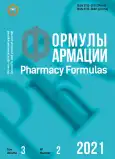Effect of organophosphorus compounds on the external respiratory functionin rats during intratracheal andintraperitonealadministration
- 作者: Kryazhevskikh A.A.1,2, Kryazhevskikh A.A.1,2, Subbotina S.N.1, Sklyarova N.A.2
-
隶属关系:
- State Scientific Research Testing Institute of Military Medicine of the Ministry of Defense of the Russian Federation
- Saint Petersburg State Chemical and Pharmaceutical University
- 期: 卷 3, 编号 2 (2021)
- 页面: 60-65
- 栏目: Biomedical Sciences
- URL: https://journal-vniispk.ru/PharmForm/article/view/72068
- DOI: https://doi.org/10.17816/phf72068
- ID: 72068
如何引用文章
全文:
详细
Due to the increasing influence of chemical factors on the human body, the experiment has been conducted using organophosphorus compounds (OPC) to stimulate poisoning cases in the production facilities. Given that the development of respiratory failureis a specific organophosphate poisoningsymptom, a comparative analysis of external respiratory function (ERF)in rats with intratracheal and intraperitoneal administration of diisopropyl fluorophosphates (DFP) has been carried out. During the research, the average lethal doses of the toxic chemicals have been established, the conditions of DFP intoxication have been modeled.Thus, LD16 was 0.284 mg/kg by intratracheal administration, 1.6 mg/kg – byintraperitoneal administration. Experimental data have shown that the intratracheal intake of OPC causes the development of respiratory failure in the first minutes after poisoning.The return of the ERF indicators to the background values was noted a day after poisoning. With the intraperitoneal administration of the toxic chemical, the rate of development of ERF disorders was lower, toxic effects persisted for two days. The data obtained can be used to make appropriate recommendations for the prevention of accidents and non-emergency cases in a production facility.
作者简介
Anastasiya Kryazhevskikh
State Scientific Research Testing Institute of Military Medicine of the Ministry of Defense of the Russian Federation; Saint Petersburg State Chemical and Pharmaceutical University
Email: gniiivm_15@mil.ru
Research Assistantat the Research Department, State Scientific Research Testing Institute of Military Medicine of the Ministry of Defense of the Russian Federation, Master Student, Saint Petersburg State Chemical and Pharmaceutical University
俄罗斯联邦, Saint Petersburg; Saint PetersburgAleksey Kryazhevskikh
State Scientific Research Testing Institute of Military Medicine of the Ministry of Defense of the Russian Federation; Saint Petersburg State Chemical and Pharmaceutical University
Email: gniiivm_15@mil.ru
Research Assistant at the Research Department, State Scientific Research Testing Institute of Military Medicine of the Ministry of Defense of the Russian Federation, Master Student, Saint Petersburg State Chemical and Pharmaceutical University
俄罗斯联邦, Saint Petersburg; Saint PetersburgSvetlana Subbotina
State Scientific Research Testing Institute of Military Medicine of the Ministry of Defense of the Russian Federation
Email: gniiivm_15@mil.ru
SPIN 代码: 7249-8174
Ph. D. In Biology, Senior Researcher at the Research Department
俄罗斯联邦, Saint PetersburgNataliya Sklyarova
Saint Petersburg State Chemical and Pharmaceutical University
编辑信件的主要联系方式.
Email: natalia.sklyarova@pharminnotech.com
SPIN 代码: 9473-6506
Ph. D. in Engineering Sciences, Associate Professorat the Industrial Ecology Department
俄罗斯联邦, Saint Petersburg参考
- Boostani R, Mellat A, Afshari R, et al. Delayed polyneuropathy in farm sprayers due to chronic low dose pesticide exposure. Iran Red CrescentMed J. 2014 May; 16 (5): e5072.
- Brenet A, Somkhit J, Hassan-Abdi R, et al. Organophosphorus diisopropylfluorophosphates (DFP) intoxication in zebrafish larvae causes behavioral defects, neuronal hyperexcitation and neuronal death. Sci Rep. 2020 Nov 5; 10 (1). doi: 10.1038/s41598-020-76056-8.
- Gorecki L, Korabecny J, Musilek K, et al. SAR study to find optimal cholinesterase reactivator against organophosphorous nerve agents and pesticides. Archives and Toxicology. 2016; 90 (12): 2831–59. doi: 10.1007/s00204-016-1827-3.
- Mew EJ, Padmanathan P, Konradsen F, et al. The global burden of fatal self-poisoning with pesticides 2006–15: systematic review. J Affect Disord. 2017 Sep; 219: 93–104. doi: 10.1016/j.jad.2017.05.002.
- Putra M, Gage M, Sharma S, et al. Diapocynin, an NADPH oxidase inhibitor, counteracts diisopropylfluorophosphate-induced long-term neurotoxicity in the rat model. Ann N Y Acad Sci. 2020. Nov; 1479 (1): 75–93. doi: 10.1111/nvas.14314.
- Mc Garry KG, Schill KE, Winters TP, et al. Characterization of Cholinesterases from Multiple Large Animal Species for Medical Countermeasure development against Chemical Warfare Nerve Agents. Toxicological Sciences. 2019; 174 (1): 124–32. doi: 10.1093/toxsci/kfz250.
- Giyanwani PR, Zubair U, Salam O, et al. Respiratory Failure Following Organophosphate Poisoning: A literature Review. Cureus. 2017 Sep 3: 9(9): e1651. doi: 10.7759/cureus.1651.
- Vengerovich NG, Drachkova IM, Yudin MA, et al. Experimental Substantiation of Inhalation Administration of Pathogenic Therapy of Toxic Convulsive Disorder for Correction of External Respiration Disorders. Bull Exp Biol Med. 2018. 165(2): 225–9. doi: 10.1007/s10517-018-4135-5.
补充文件










